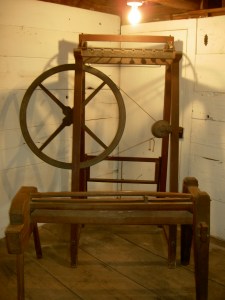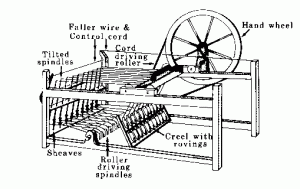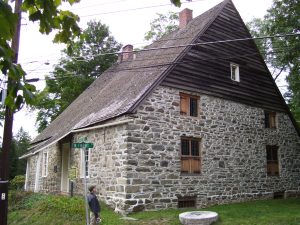Caption: This spinning jenny is a typical specimen of the kind often found in homes during colonial and post-colonial times.  It was given to the Memorial House (the Jean Hasbrouck house) by its owner, William Henry Dill Blake, whose family owned the spinning jenny before him and whose wife and daughter (both named Matilda Booth Blake) likely used it regularly as a household chore. Built in the late 18th century, this spinning jenny is a reminder of the role of women in the establishment of one of New Paltz’s successful families.
It was given to the Memorial House (the Jean Hasbrouck house) by its owner, William Henry Dill Blake, whose family owned the spinning jenny before him and whose wife and daughter (both named Matilda Booth Blake) likely used it regularly as a household chore. Built in the late 18th century, this spinning jenny is a reminder of the role of women in the establishment of one of New Paltz’s successful families.
Physical Description: This spinning jenny is comprised of a wooden frame and a large, slightly corroded iron wheel with four spokes placed at even intervals. On the right-hand side of the wheel is a grooved iron cylinder (also sporting slight corrosion with age), likely used for winding the finished thread. On the front left pole of of the frame are scratched the initials “HB;” additionally, the spinning jenny is marked with the number 213, likely a production or maker’s mark. According to the file in Historic Huguenot Street records, there are likely some pieces missing.

Diagram of a Hargreave spinning jenny (since the image above is the only one available of the Blakes’ jenny.
Provenance: The first clue to determining the origin of the spinning jenny is the inscription “HB” on the frame. As this spinning jenny was built in the late eighteenth century, while the invention was still fairly new (American Fabrics Magazine 220), and also considering that William H.D. Blake was born much later, in 1843 (according to the Blake family papers on file at Huguenot Street), it is logical to assume that the spinning jenny was probably first owned by Blake’s grandfather or great-grandfather. Also according to Huguenot Street records, the spinning jenny was owned by the family until Blake’s donation of the piece in 1910; it most likely came into his possession as a family object that was passed down to him. The maker’s mark, “213,” yields no significant results, though a search of the history of the spinning jenny reveals that several were manufactured underground (that is, without the inventor’s permission) because the design was so brilliantly simple and that there was dispute during the time of the spinning jenny’s true inventor and origin (Baines, Arkwright); Blake’s spinning jenny therefore could have been manufactured by any number of individuals.
Narrative: The Blake family moved to New Paltz in 1881, when they purchased the DuBois farm; shortly thereafter, William and Matilda, the two youngest Blake children, were born. During this time, spinning, weaving, knitting, and almost all other forms of textile production were considered “women’s work,” as such activities allowed them to work primarily in their homes (thus fulfilling the typical duties of wife and mother) while still providing the family with additional income from selling the resulting product. Family workshops were the norm, to such an end that almost every household contained at least one “knitting frame” (loom) and one spinning wheel (AFM 217). According to Historic Huguenot Street records, the Blake spinning jenny replaced an older spinning wheel previously owned by the family; one can easily imagine the mother Matilda spinning yarn at home on a typical day to the sounds of her children’s laughter and the pitter-patter of little feet. Later, as the daughter Matilda grew bigger, her mother would have taught her how to spin the yarn herself, to the end of her being expected to produce her own quantity of yarn as an adult. Unlike her brothers, Matilda spent her entire life on her family’s farm on Libertyville Road in New Paltz. It is likely that she continued to make use of the spinning jenny through her school years up until her enrollment in the New Paltz Normal School. Beyond that, the latest mention of the spinning jenny in historical records is a newspaper clipping, dated May 6, 1910, that announces William H.D. Blake’s donation of the piece to the Memorial House. While a seemingly random choice, the spinning jenny is actually a quite significant piece, as it symbolizes an industry and a community of workers that played a very large role in shaping the economy of New Paltz, as well as a symbol of the financial success of one of New Paltz’s most successful farming families.
Works Cited:
American Fabrics Magazine. Encyclopedia of Textiles. Englewood Cliffs, NJ: Prentice-Hall, 1960. Print.
Baines, Edward (1835). History of the cotton manufacture in Great Britain;. London: H. Fisher, R. Fisher, and P. Jackson.
Roth, Eric. Ed. “William H. D. Blake Family Papers (1794-1982).” Historic Huguenot Street Archives. Historic Huguenot Street, 10 July 2002. Web. 12 May 2015. <http://www.huguenotstreet.org/william-h-d-blake-family-papers/>.
Infinite thanks to Ashley Trainor and Carrie Allmendinger from Historic Huguenot Street for sharing their records, knowledge, and expertise with me for this project.

You must be logged in to post a comment.